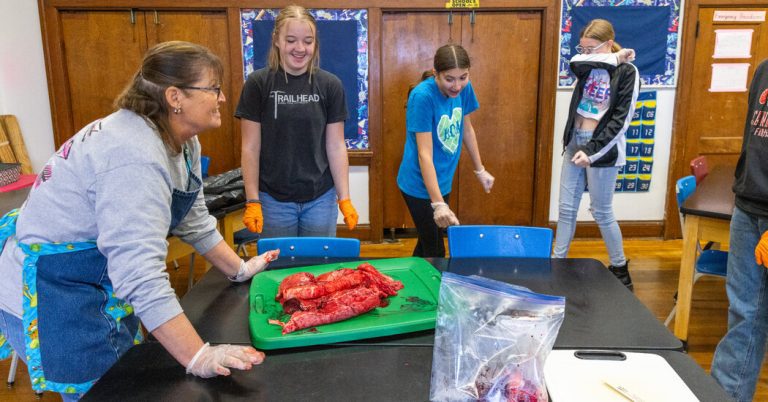At Maysville High School in Maysville, Mo., population 1,100, classes can be a little tough for underachievers. Coursework can involve reading and algebra, but also a serious amount of blood and guts.
In 2022, the high school, an hour’s drive north of Kansas City, added a farm-to-table elective taught by a family and consumer science teacher, Amy Kanak, who works with an agriculture teacher, Brandi Ellis. Students were already learning to harvest and process animals and wild game in their agriculture classes and to dissect organs in their science classes. The new lesson gives them the opportunity to cook meals using the harvested meat, a logical conclusion to the hard work of students in other classes. Ms. Kanak provides instruction on the tail end of the nose-to-tail process, meal prep, performance, budgeting, and bulk cooking.
But it all starts with the most difficult and dirty part: slaughtering animals and breaking them. For many students, it is the first time they have held a knife and slaughtered. Ms. Kanak hopes that students will finish her lesson with an understanding of where their food comes from.
Ms Ellis, who sees the lessons as vital in an era of rising grocery bills, said: “It forces them to step out of their comfort zone a bit.”
Garrett Bray, then a senior at Maysville High School, pulls a fresh doe out of the woods in 2022 on his family’s property. Garrett learned to hunt from his father and has been hunting since he was young.
Max DeSon, right, helps drag two ladders out of Garrett’s pickup. Normally, Garrett would have dressed the deer himself, but he handed them over for the students to learn about processing and butchering.
Sophia Redman, freshman 2022, takes a first cut on a doe during an agriculture class.
Kaleb Jestes, left, processes venison and sorts it into different cuts during a farm-to-table food class. A single deer averages 60 to 70 pounds of processed meat, making it an affordable option if you know how to hunt and process the animal yourself. Deer permits in Missouri, as of 2024, start at $7.50 for antlerless deer or $18 for any deer. Youth tags cost even less.
Eighth grade science teacher Cindy Eggleston shows her students, from right, Keely Hardin, Makenzie Mason and Kella Morris, newly harvested deer organs that will be part of a heart and lung anatomy lesson.
Max Heinz collects a rooster from a shed outside the agriculture building at the start of the school day in December 2023. A local resident called Ms. Ellis, asking to donate seven overly aggressive roosters to the program. Ms. Ellis teaches students to kill and process chickens each year, often after raising them at school.
Slaughtered roosters bleed in the trash cans inside the agriculture building.
Makenzie, 2023, left, taking the water temperature as her classmates Nathan Schnitzer, center, and Bo May hold their chickens during an agriculture class. Different classes during the day are involved in the whole process: killing, destroying the carcasses by first immersing them in boiling water and preparing the birds to cook and eat by removing organs and legs.
Keagan Reeder, left, and Cooper Ray, center in hat, stand by as Colton LeMunyon, wearing a Buffalo Bills hoodie, grills chicken marinated by students.
Colton digs into a fried stick from a rooster killed by a class that morning. The students noticed how tough the meat was, probably due to the age of the roosters.
From right, Kameron Keesaman, Robert Stinley Jr. and Bo Zeikle don their aprons at the start of a cooking class.
Frying chicken livers from the roosters that the agriculture classes had killed and processed the previous week.
Charlee Kimbrell, left, Robert Boucher, center, and teacher Amy Kanak “cheer up” fried chicken livers before tasting.
Chicken-fried venison steak with gravy along with French fries and green beans, prepared and served in Ms. Kanak’s classroom, the end of a process that began on the flatbed of a pickup truck.
Katie Currid contributed reporting.




